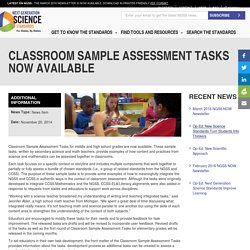

Integrating Science and Engineering Practices into Assessments. The new vision for science education articulated in the Next Generation Science Standards guides students toward a “three dimensional” understanding of science—one that integrates disciplinary core ideas, crosscutting concepts, and real-world practices from science and engineering.

With this new three-dimensional model for learning, students will need new assessments to demonstrate their knowledge and competencies, ones that integrate multiple strands of student abilities. Developing assessments that combine these multiple strands presents new challenges for educators, from developing informal classroom formative assessments to those creating high-stakes state-level testing. This tool offers between four and eight possible task formats for each of the science and engineering practices listed in the Next Generation Science Standards. It can be a great way for educators to brainstorm new activities or to adapt their existing lesson plans to this new three-dimensional vision. NGSSTaskFormats Feb2016 v4. Developing Assessments for the NGSS.
How teachers can develop formative assessments that fit a three-dimensional view of science learning : StemTeachingTools. Research Brief: Designing an Assessment System that Measures Three-Dimensional Science Learning : StemTeachingTools. Research Brief: The Informal Formative Assessment Cycle as a Model for Teacher Practice : StemTeachingTools. Science Assessment. Next Generation Science Assessment. Classroom Sample Assessment Tasks Now Available. Classroom Sample Assessment Tasks for middle and high school grades are now available.

These sample tasks, written by secondary science and math teachers, provide examples of how content and practices from science and mathematics can be assessed together in classrooms. Each task focuses on a specific context or storyline and includes multiple components that work together to partially or fully assess a bundle of chosen standards (i.e., a group of related standards from the NGSS and CCSS). Developing Assessments for the Next Generation Science Standards. Task, middle school students engage in argumentation about disciplinary core ideas in earth science.

As with the previous example, the formative assessment activity is more than just the initial question posed to students; it also includes the discussion that follows from student responses to it and teachers’ decisions about what to do next, after she brings the discussion to a close. In this activity, which also takes place in a single class session, the teacher structures a conversation about how the movement of water affects the deposition of surface and subsurface materials. The activity involves disciplinary core ideas (similar to Earth’s systems in the NGSS) and engages students in practices, including modeling and constructing examples. It also requires students to reason about models of geosphere-hydrosphere interactions, which is an example of the crosscutting concept pertaining to systems and system models.9.
Developing Assessments for the Next Generation Science Standards. Task, middle school students engage in argumentation about disciplinary core ideas in earth science.

As with the previous example, the formative assessment activity is more than just the initial question posed to students; it also includes the discussion that follows from student responses to it and teachers’ decisions about what to do next, after she brings the discussion to a close. In this activity, which also takes place in a single class session, the teacher structures a conversation about how the movement of water affects the deposition of surface and subsurface materials. The activity involves disciplinary core ideas (similar to Earth’s systems in the NGSS) and engages students in practices, including modeling and constructing examples.
It also requires students to reason about models of geosphere-hydrosphere interactions, which is an example of the crosscutting concept pertaining to systems and system models.9. Developing Assessments for the Next Generation Science Standards. This example of an assessment task illustrates the concept of three-dimensional science learning, the kinds of instructional experiences that are needed to support its development, and the assessment tasks that can provide documentation of this kind of learning.7 It also shows how a performance expectation can be used to develop an assessment task and the associated scoring rubric.

Specifically, it illustrates how students’ classroom investigations yield products that can be used as formative assessments of their understanding of and ability to connect disciplinary core ideas. Instructional Context The curriculum materials for the 7th-grade unit, “What Is Going on Inside Me,” were developed as part of the 3-year middle school curriculum series developed by the Investigating and Questioning our World through Science and Technology (IQWST) project (Krajcik et al., 2008b; Shwartz et al., 2008). 7As noted in Chapter 1, we use examples of assessment tasks to illustrate the discussion.